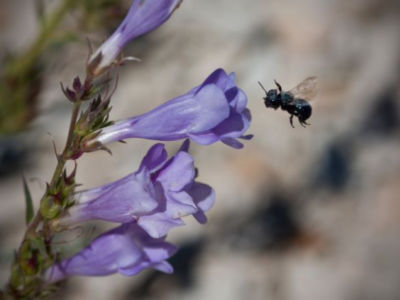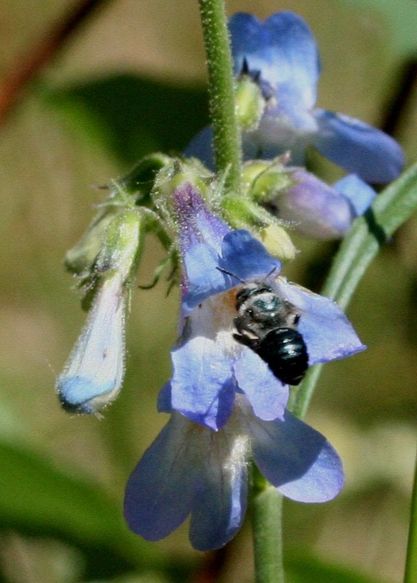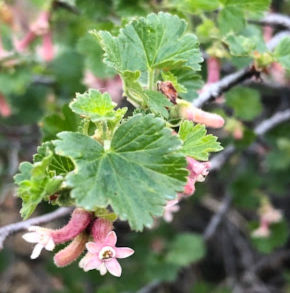Mason bees, in the genus Osmia and the family Megachilidae, are extremely efficient pollinators. They are known to be one of the most important and effective pollinators for the genus Penstemon. The photo on the left below shows a mason bee on Penstemon scariosus var. albifluvis, which is a rare Penstemon found in Rio Blanca County, Colorado. I took this photo in 2010 while doing fieldwork for the Natural Areas Program. The photo on the right is a Mason bee on Penstemon degneri. I took this photo during graduate research in 2008 near Canon City, Colorado.
Above: A mason bee is heading in to the flower of Penstemon scariosus var. albifluvis, White River beardtongue. On the right is a Penstemon degneri, Degner’s beardtongue, also waiting for a mason bee. Both of these particular penstemons are endemic, found only in very restricted, specific places.
©Carol English
Mason bees are also very important for orchard crops in the United States. One mason bee, Osmia lignaria, has been estimated to do the work of 75 honey bees. Mason bees have very different foraging techniques compared to non-native European honey bees. While honey bees are highly meticulous, visiting every flower along a branch before moving on, mason bees are chaotic and crash into flowers while rubbing their abdomen all over the blooms covering her scopa hairs. (The scopa is a dense patch of long, branched hairs either on the leg or on the underside of the abdomen.) The pollen baskets that honey bees use to carry their pollen home often means that far less of the pollen reaches other plants. Mason bees fly closer to home, usually little more than 100 meters. Because of this, they don’t need pollen baskets and can afford to lose a few grains of pollen on the flight back to the nest. The advantage of having scopa hairs that can readily pick up and brush off pollen grains combined with the mason bee’s erratic method of jumping from flower to flower is the perfect combination for superior cross-pollination.
Carol English
Native Plant Master
Native Plants for Mason Bees
Native shrubs in the Ribes genus are loved by mason bees, this one is Ribes cereum, Wax currant. Clusters of bell-shaped flowers in spring. This shrub is compact and mounded betweeen 3 – 5 feet with bright red berries used by birds in fall. ©SPD
Penstemon strictus, Rocky Mountain penstemon, is loved not only by mason bees but also by a wide variety of other pollinators. Very easy to grow and has evergreen foliage. Colorado has over 60 species of native penstemons, all water thrifty, and some of them are bound to be adapted to conditions in your garden. ©SPD
Mason bees are also attracted to this native shrub, Rhus trilobata, skunkbush, another highly drought resistant plant. Small yellow flowers clustered in spikes appear in spring, followed by red berries and colorful foliage in fall. Provides food and good cover for song and game birds. ©SPD





